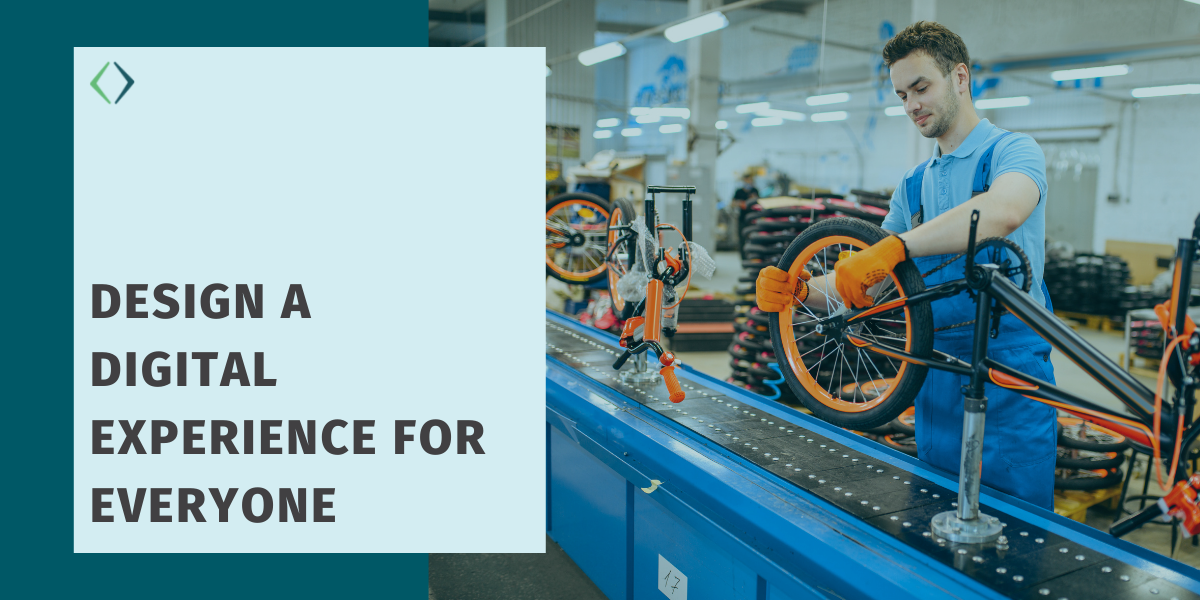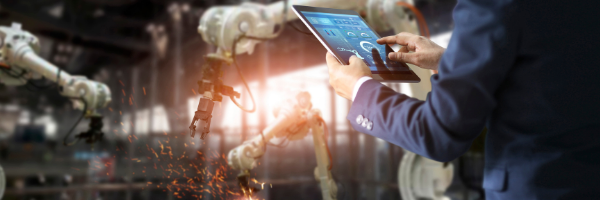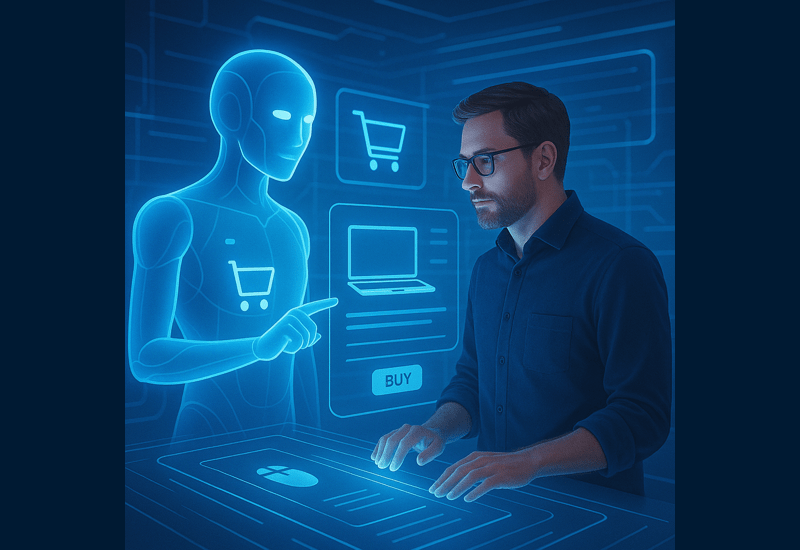
How manufacturers can create a seamless digital experience—for business buyers, distributors, and maybe even consumers— that accelerates growth.
Manufacturing companies are well known for their engineering and logistical prowess, but not necessarily for delivering a great digital experience. That is starting to change. Many manufacturers pivoted to eCommerce in 2020 when their direct sales teams could no longer make on-site calls. In fact, a KPMG survey of manufacturing-industry CIOs suggests that using technology to improve the customer experience is now a board-level priority¹.
Meanwhile, long-term trends that promote digital transformation are accelerating: millennials and younger generations are moving into senior management roles, and customers are researching and buying more online. For example, building and construction buyers use digital channels 80 to 90 percent of the time to gather product information, read reviews, compare prices, and check product quality and availability².
Business customers and even consumers also tend to trust manufacturers—for example, more than half of shoppers visit brand websites for product information rather than retailer websites³—and opt to buy from them, too. While direct selling can sometimes cause channel conflicts, a growing number of distributors are interested in fulfilling orders placed on manufacturers’ sites and participating in manufacturer-run marketplaces.
This article from our partner, Adobe, will look at how manufacturers are designing digital experiences for everyone, including customers, distributors, resellers, and consumers, in ways that improve agility and accelerate growth.
The Digital Opportunity
Manufacturers today understand that delivering a great digital experience can help their business succeed across multiple dimensions, including new customer acquisition, customer loyalty, and sales volume through distributors and resellers.
In a survey by Fictive, 97 percent of manufacturing leaders said COVID-19 has created business opportunities, and 87 percent highlighted digital transformation as a critical area of focus4. However, just 14 percent believed their digital transformation activities were adequately funded. This suggests manufacturers who choose to invest in the digital experience— and enable their customers to do more online—could be at a major competitive advantage.
Better experiences for business customers
Over the past several years, leading manufacturers have added new digital experiences like eCommerce for their business customers. In 2019, B2B eCommerce sales for manufacturers grew by nearly 21 percent to $430 billion, almost 20 times faster than US manufacturing sales through other channels5.
And then 2020 happened. Direct sales channels were disrupted as sales teams began working from home and having meetings online rather than in the field. Business buyers also changed their work habits, spending more time at home and online—often during odd hours such as late at night. These changes prompted many more manufacturers to introduce eCommerce and create a range of digital experiences for their business customers.
The most successful experiences provide a range of helpful on-demand capabilities, including easy product research and configuration, self-service purchasing, automated replenishment, and account management. They allow a customer to perform almost any task—ask a product question, submit a warranty claim, check order status, etc.—online, but they complement rather than replace direct sales relationships.
In fact, great, business-facing digital experiences should empower direct sales reps to deliver even better service through seller-assisted shopping, online price quotes, and live chat.
Provide self-service account management.
Leading manufacturers make it easy for business buyers to access their account information, run reports, and manage their purchases. Through eCommerce sites or portals, they allow customers to do all these things online:
- View order status
- Get a full view of all company spending across buyers
- Track their credit balance
- Access and download invoices
- Manage returns
- Pay bills
- Manage warranties
- Update company buyers and what they can do on the site
- Approve purchase orders
Not only do these eCommerce sites improve the customer experience, they also make life easier for direct sales reps. When customers are used to doing many tasks for themselves, direct sales reps can spend more time on account strategy and planning. The net result for manufacturers is greater efficiency—and satisfied customers who are more likely to buy more.
Make it easier to research and configure products.
For years, it’s been clear that business buyers often prefer to research product information on their own rather than have a meeting with a salesperson. More than 70 percent of B2B buyers have fully defined their needs before engaging with a sales representative6. In fact, almost 50 percent of B2B buyers have already made a decision before reaching out6.
To reach this growing pool of customers, successful manufacturers are giving them many different options for researching products through their websites. They are providing a wider range of content and richer experiences that typically include the following:
- Detailed product descriptions
- Multiple product images
- Videos
- User reviews
- Diagrams and CAD drawings
- Usage instructions
- Information on related certifications
Product recommendations with artificial intelligence (AI)
A growing number of manufacturers are also using AI to provide highly relevant product recommendations, which business buyers find extremely valuable. In fact, 70 percent of business buyers said personalized recommendations helped them to obtain more value from their vendors— and 53 percent said they would pay as much as 5 percent more for them7.
Ideally, these product recommendations should come from each customer’s unique product catalog. For customers with very large catalogs, these tailored recommendations can be especially helpful.
Contextualizing products with augmented reality (AR)
Leading manufacturers routinely take advantage of AR when designing products and processes. Now they also use it to contextualize products by showing how they might look in customer environments. For example, a lighting manufacturer might allow customers to see how a particular desk lamp could look on one of the shared desks in their office. Ideally, they should be able to easily swap in other lamps with varying color, size, and lighting element options.
Easy-to-use product configuration tools
Another way manufacturers are helping customers get information online is by giving them access to online configuration tools. These tools guide customers through step-by-step configurations and automate some tasks normally handled by sales. As noted above, 3D imagery as well as AR can be used to provide additional visual context for different configurations. An industrial equipment manufacturer could, for example, allow customers to see how different configurations of their fabrication technology would fit into an existing factory space.
After customers complete the configuration process (which should go faster online than by meeting), a sales rep can easily confirm the order with a quick email or phone call. As a result, customers save time—and feel good about their experience.
Simplify purchase processes.
B2B purchase processes can be complex, requiring multiple approvals and signatures. Some may require the creation of formal purchase orders. Leading manufacturers are using their eCommerce platforms to digitize these processes. For example, they may use automation to route purchase requests for approval according to pre-defined workflows, and send contracts for digital signatures and counter-signatures.
Another way manufacturers are simplifying the buying process is by making it easier for a customer to reorder products online. They can provide pre-approved requisition lists the buyer can pick from, allow past orders to be rerun, or even offer subscription services or automated reorders.
Digitally connect products and services.
Manufacturers typically offer warranties and service contracts to pair with their products. Using digital technologies can connect products and services into a single seamless experience. For example, manufacturers may apply QR codes to their products that customers can scan to look up their warranties, or they can provide a marketplace where owners can look up local service providers and book appointments.
Other manufacturers use the Internet of Things (IoT) to make their products smarter and connect them to their digital experience. For example, product health data can be piped to the customer as well as to the manufacturer’s service department. Customers can see problem indicators on their service dashboard and be notified when it’s time to order replacement parts or replenish consumables (printer cartridges, etc.).

Improve customer service.
While business buyers would like the option to do almost everything online, they also want the ability to connect with their sales reps. Fortunately, an eCommerce or digital experience platform can complement direct sales relationships rather than replace them. For example, guided selling tools allow manufacturers’ sales reps to help customers through the buyer’s journey online, and even place orders on their behalf.
Likewise, live chat allows customers to instantly ask any questions that come up while viewing the website. For example, a customer may look up their recent purchase history and have a question about a particular transaction. Through live chat, they can connect with a sales rep and get the information they need. Other forms of chat powered by AI may connect with customers based on their behavior. For example, if someone watches a how-to video and then lingers on a support page, they may get a chat notification asking if they need help.
Be available on popular marketplaces.
A growing share of B2B eCommerce happens on Amazon and other large marketplaces—and some customers may prefer to buy through these channels rather than through your website or distribution network. To avoid competing with their own eCommerce sites or resellers, many manufacturers choose to offer only older versions of their products through marketplaces.
Some manufacturers are also creating their own marketplaces, offering a wide range of complementary products that customers can buy in one place. Not only does this allow manufacturers to improve the customer experience, it also lets them increase revenue by sharing in other vendors’ sales on their site.
Use data to uncover customer needs.
One way manufacturers can deliver a better digital experience is to use their customer data. This data may be stored in many different locations—ERP, CRM, eCommerce, marketing automation, and other systems may each contain valuable information about customer preferences.
By combining all this data into a single unified customer record, you can start looking at broad trends in customer behavior and shape your digital experience accordingly. For example, you might be able to identify your most popular products for customers in different locations or industries. This will help you decide which products to promote to different parts of your customer base.
Better experiences for distributors and resellers
Distributors and resellers occupy a broad spectrum of digital maturity. Some have their own eCommerce storefronts and may need to pull product imagery and manufacturer messaging into their experience. Or they may want manufacturers to act as drop shippers, fulfilling orders placed on their website. These more digitally mature partners may also prefer to order from you online.
However, many distributors are less digitally mature. For example, industrial distribution is known for being fragmented, and 56 percent of these firms are family owned.8 Many of those distributors may want a way to benefit from eCommerce without having to build and maintain their own site. Manufacturers can help them get online or benefit from digital selling in a number of ways:
- Allow local distributors to fulfill orders placed online
- Set up marketplaces—similar in concept to Amazon—where multiple distributors can sell online without having to build their own website
- Build eCommerce websites for their distributors
Excellent direct buying experiences
A growing number of manufacturers are augmenting their existing distribution networks with direct sales channels. These can be direct selling websites aimed at business or consumers. Both strategies can succeed, as both business buyers and consumers tend to trust manufacturers and like to buy from them.
Offer direct sales to business customers.
The typical business buyer’s journey is longer and more complex than ever. Nearly three-quarters of today’s B2B buyers say they rely on more sources to research and evaluate purchases9. As business buyers get more overwhelmed, they seek out ways to simplify the buying process.
Many business buyers believe that purchasing directly from a manufacturer’s website is less cumbersome and time-consuming than going through a distributor or reseller. Not surprisingly, leading manufacturers are setting up eCommerce stores where select customers can buy direct. The key to success is to avoid conflicts between new digital channels and existing distribution relationships.
Create a direct-to-consumer website.
Over the past few years, a growing number of manufacturers have made the leap into direct-to- consumer sales. Consumers generally trust manufacturing brands, and research conducted last year suggests more than 80 percent of consumers are likely to buy from a direct-to-consumer business within five years10. Direct-to-consumer businesses like Warby Parker and Dollar Shave Club (recently bought by Unilever for $1 billion), among others, have enjoyed outsized growth. And Tesla’s success shows the direct-to-consumer model can also work outside the realms of apparel and beauty.
For manufacturers, getting started with direct-to-consumer selling typically requires the following:
- A thorough understanding of the kind of experience consumers interested in their product want, including shipping, delivery, and payment preferences
- A strategy for pricing and packaging products to attract consumers
- Defined processes for fulfilling direct-to-consumer sales and keeping inventory data up to date
- An eCommerce platform that can deliver a high-end consumer experience and integrate with their ERP and other back-end systems
Manufacturers with existing distribution partnerships will also have to figure out how their direct-to-consumer website will affect those relationships. In some cases, the best option may be to sell one set of products direct to consumers and another through existing distributors.

Manufacturing firms have the potential to become leaders in digital experience, just as they are in logistics and operations. Digital transformation can help manufacturers deepen relationships with existing customers and attract new ones. It can also help revitalize distribution networks and strategies and even generate new revenue streams.
Learn more about how manufacturers can develop a successful direct-to-consumer online experience with our Adobe Commerce B2B Packages!
Sources
1 https://home.kpmg/xx/en/home/insights/2021/02/cio-industrial-manufacturing-survey-2020.html
2 LEK via HBR: https://hbr.org/2020/09/industrial-firms-need-to-give-their-customers-a-digital-experience
3 https://marketingland.com/survey-consumers-seeking-buy-directly-brands-vs-retailers-222955
4 Fictive via Forbes: https://www.forbes.com/sites/daveevans/2020/07/23/2020-state-of-manufacturing- covid-19-impacts-calls-for-a-digital-superhero
5 https://www.digitalcommerce360.com/2020/07/22/covid-19-manufacturers-adjust-to-the-faster-growth- of-ecommerce/
6 “The Growing Buyer-Seller Gap: Results of the 2018 Buyer Preferences Study,” Miller Heiman Group, 2018. https://www.millerheimangroup.com/resources/resource/2018-buyer-preference-study-results/
7 “What B2B Buyers Want in 2019: Speed, Personalization and Intelligence,” survey of 1,000 procurement and purchasing leaders, Hanover Group (sponsored by PROS).
8 https://www.inddist.com/economy/article/13777836/industrial-distributions-72nd-annual-survey-of- distributor-operations
9 https://www.demandgenreport.com/resources/research/the-2019-b2b-buyers-survey-report/
10 https://www.retaildive.com/news/81-of-consumers-plan-to-shop-direct-to-consumer-brands/539087/



